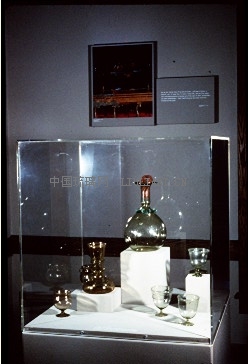When cooled, the exterior surface was cut back to produce figural compositions on multiple planes which exploited the shading variations made possible depending upon the degree of thickness or thinness of the reserved white. Cameo glass had an advantage over cameo carving in shell or stone in that the artisan could control the placement and relative depth of the contrasting materials in his blank. Cameo glass was a development emerging from the prosperity of the Pax Romana of the Augustan period in Rome (27 B.C. - A.D. 14). The technique seems not to have been practiced in ancient Italy after the first century A.D. Only thirteen complete cameo vessels are presently known worldwide. Preserved fragments number only in the hundreds.
Dionysiac scenes seem to have been the favored subject matter for cameo vessels. Epic legends were also represented (as, on the famous Portland Vase in The British Museum an enigmatic mythological/epic tale unfolds). Suetonius tells us that the Emperor Nero (A.D. 54-68) "upset the table and dashed to the floor two favorite goblets which he called 'Homeric' after the Homeric tales carved upon them." These goblets were probably cameo-carved. The preciousness of cameo vessels is suggested by a still life painting from Herculaneum in which a cameo-carved jug bearing a scene with a horse and rider figures prominently.
Mythological scenes were also engraved into colorless glass vessels. Alexandria produced a coveted class of this genre during the second century A.D. Fragmentary examples of this ware from Karanis prove that such glasses must have been made in Egypt, no doubt at Alexandria, for the inhabitants of provincial Karanis were not likely to import luxury items from Rome, Cologne, or Sidon. Completely preserved vessels of this type found in the West document complex captioned figural scenes. Vessels which were wheel-cut with elaborate designs of facets and grooves were also greatly prized. Some of these were executed on exquisitely thin glass; while others embellish weighty vessels.

On the eastern frontier of Rome's active military purview, massive clear vessels embellished with deeply cut facets were a specialty.
Whole vessels of forms similar to our fragment excavated at Seleucia have been found in Japan. One was buried with the Emperor Ankan in A.D. 535. Unlike the devitrified examples found in the Middle East, the cut-glass vessels exported to Japan are still in pristine condition--their facets dazzling like so many mirrors.
上一页 [1] [2] [3] [4] [5] [6] [7] [8] 下一页
|




